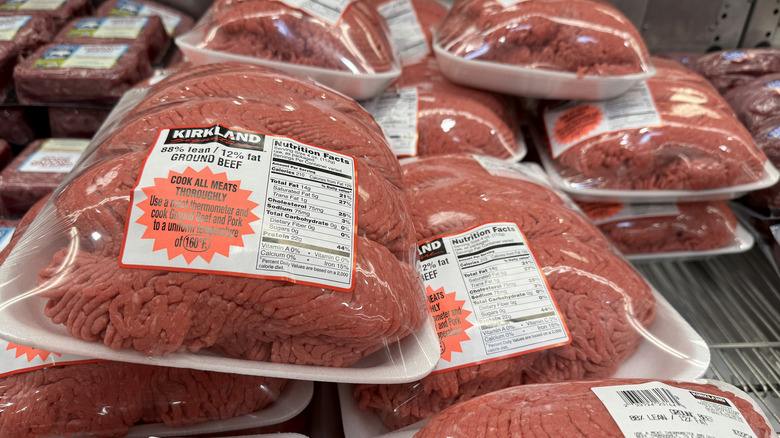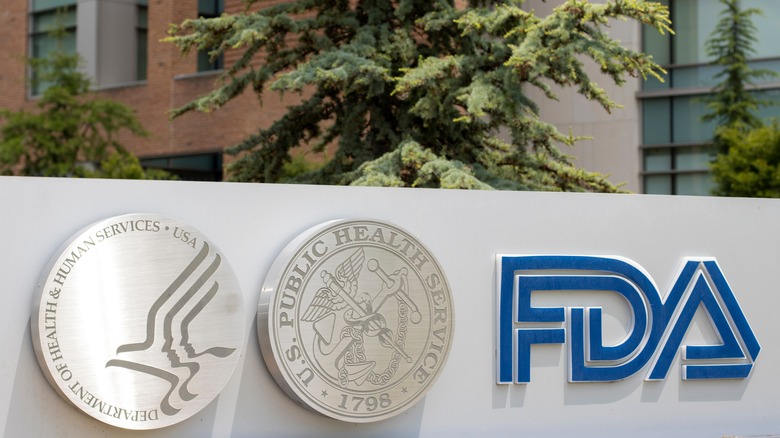What's Up With The Nitrogen In Ground Beef Packages?
If you've heard that ground beef packaging is pumped with gases like nitrogen — well, it's true, but it's also not something to be worried about. This process is sometimes called "modified atmosphere packaging," and it works to maintain the red color of ground beef. Oxygen makes meat change color, becoming more brown or gray within a couple of days of exposure. Packaging full of nitrogen gets rid of the chemical element, helping the meat stay red.
It's not just nitrogen that gets added to ground beef packaging: Carbon dioxide and carbon monoxide are also usually in the mix. This combination of gases can keep beef looking an appetizing red color for around two weeks (and maybe more). This trick doesn't just work for ground beef, either — it's also used on other beef products (like steak and non-ground cuts), as well as other red meats like lamb. The FDA and USDA approves of these uses of gases in meat packaging, although they may not be listed on the ingredients list because they're not part of the actual meat per se.
Why nitrogen is generally safe
It's important to realize that when nitrogen is used in meat processing, it's in the packaging, not the meat itself. And either way, you're exposed to nitrogen all the time — it makes up 78% of the earth's atmosphere and the air you breathe in. You could also argue that it's not really the nitrogen that makes your ground beef look more red for longer — it's the lack of oxygen. Nitrogen is fairly common in food packaging. It's found in wine bottles and packaged coffee (among other products) to keep the products fresh and protect them from oxidation damage.
For this reason, there's no shortage of advocates for these kinds of uses of nitrogen and carbon dioxide. The FDA claims that by eliminating oxygen from meat packaging, these gases may help meats last longer and prevent the growth of undesirable organisms like mold. It's worth noting however that there are safety concerns about the use of liquid nitrogen in food, but this is not the same thing. Liquid nitrogen is very uncommon in food and is generally used for novelty purposes to cool food to -320 degrees Fahrenheit. You wouldn't encounter it in supermarket or butcher meat because it would actually damage the product.
Possible safety concerns with gas-packaged meats
While the use of nitrogen is not so controversial, there's debate around the use of carbon monoxide for similar ends (such as keeping tuna fresh). The amount of the gas in a single portion of packaged meat is minuscule — equivalent to about one two-hundredth of that in one cigarette. However, it's still banned in a number of places, including the European Union and Japan. This is partly due to concerns about its toxicity, but experts have also spoken out against it because carbon monoxide can falsely make meat look fresher than it really is.
This brings up a potential indirect concern with the use of nitrogen in packaging, even though it's considered safe and wholly non-toxic. The fact that these gases keep meat looking red and fresh means that consumers could be misled into buying beef that's a lot older than it appears. However, there are other ways to determine whether ground beef — which spoils faster than standard cuts — has gone bad, like by smell or touch. Nitrogen-treated meat will still give off other signs that it's gone bad, like a rotten smell. Plus, responsible retailers should know when meat is still safe to sell (for example, with expiration dates) and take it off the shelf when it's past that point, regardless of appearance.


